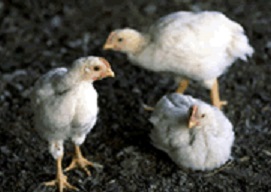Avian Influenza

Photo credit: U. S. Department of Agriculture
Avian influenza (or bird flu) is a disease of birds caused by infection with avian influenza A viruses. These viruses are excreted in the droppings, saliva, and nasal secretions of infected birds. Avian influenza A viruses usually do not infect humans; however, sporadic cases have been reported. These viruses can be transmitted to unprotected workers who have contact with infected wild birds, poultry, or contaminated materials or surfaces.
Domestic poultry may be infected with highly pathogenic avian influenza (HPAI) A viruses or low pathogenic avian influenza (LPAI) A viruses:
- The highly pathogenic viruses spread quickly and may kill nearly an entire poultry flock within 48 hours.
- The low pathogenic viruses may not cause symptoms or may cause only mild symptoms such as ruffled feathers or a drop in egg production.
The classification of low pathogenic or highly pathogenic avian influenza A virus refers to the ability of the virus to cause disease in chickens in the laboratory, not in humans. Human infection with low pathogenic and highly pathogenic avian influenza A viruses have resulted in a range of symptoms from mild to severe.
Avian influenza A viruses are a public and occupational health concern for several reasons, including:
- Some of these viruses have passed sporadically from poultry to humans and caused serious illness and death.
- They may change into a form that is highly infectious in humans and spreads easily from person to person.
- As these viruses threaten domestic poultry throughout the world, they are also a risk to workers worldwide who have contact with poultry.
Which animals can be infected?
Avian influenza A viruses occur naturally among wild aquatic birds worldwide. Avian influenza viruses have also infected other animals, including ducks, chickens, turkeys, pigs, whales, horses, seals, dogs, and cats. Influenza A viruses that infect one animal species may sometimes cross over and cause illness in another species, including people.
For more information: CDC Transmission of Avian Influenza A Viruses Between Animals and People.
Which workers are at risk?
Avian influenza A viruses usually do not infect humans; however, sporadic cases have been reported. The disease can be transmitted to unprotected workers who have contact with infected wild birds, poultry, or contaminated materials or surfaces.
Examples of poultry workers and other workers at risk include the following:
- Broiler breeder farms, hatcheries, grow-out farms, and processing plant workers
- Layer farm workers
- Turkey farm workers
- Disease control and eradication workers (including Federal, contract, and company workers)
- Live-bird market workers
- Wildlife biologists who handle birds
- Animal welfare and rescue workers who handle infected animals
- Animal control workers who handle infected animals
How do workers become infected?
Avian influenza A viruses are excreted in the droppings, saliva, and nasal secretions of infected birds. Human infection may occur when avian influenza A viruses infect humans through the mouth, nose, eyes, or lungs. Scientists believe that the virus may be transmitted to humans from contact with one of the following:
- Infected wild birds or poultry that are sick or dead
- Droppings of infected birds
- Contaminated litter
- Contaminated materials or surfaces such as egg collection containers
Protective measures should be taken by anyone likely to have exposure to avian influenza A viruses.
What are the symptoms?
The reported signs and symptoms of low pathogenic avian influenza (LPAI) A virus infections in humans range from conjunctivitis to influenza-like illness (e.g., fever, cough, sore throat, muscle aches) to lower respiratory disease (pneumonia) requiring hospitalization.
Highly pathogenic avian influenza (HPAI) A virus infections in people have been associated with a wide range of illness from conjunctivitis only, to influenza-like illness, to severe respiratory illness (e.g. shortness of breath, difficulty breathing, pneumonia, acute respiratory distress, viral pneumonia, respiratory failure) with multi-organ disease, sometimes accompanied by nausea, abdominal pain, diarrhea, vomiting and sometimes neurologic changes (altered mental status, seizures).
Where are workers at risk?
Avian influenza A viruses are routinely detected in wild birds. Around the world and in North America, avian influenza A outbreaks occur in poultry from time to time. Outbreaks of some avian influenza A viruses in poultry have been associated with illness and death in humans in Asia, Africa, Europe, the Pacific, and the Near East. While very rare, some avian influenza A viruses have caused illness in humans in North America.
For more information: CDC avian influenza current situation information.
- Page last reviewed: May 19, 2017
- Page last updated: May 19, 2017
- Content source:
- National Institute for Occupational Safety and Health Education and Information Division


 ShareCompartir
ShareCompartir